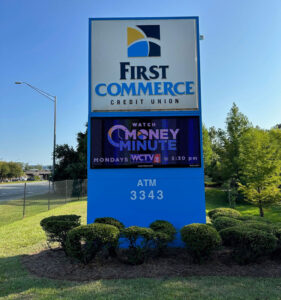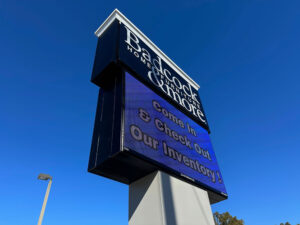 The Leon County Sign Code is a comprehensive framework of regulations governing signage within the county. This summary offers a concise overview of its key provisions and objectives. It is essential to note that this is just a summary for your convenience, and for a complete understanding of the regulations, it is strongly recommended that you refer to the full Leon County Code of Ordinances, which can be found on the official Leon County website.
The Leon County Sign Code is a comprehensive framework of regulations governing signage within the county. This summary offers a concise overview of its key provisions and objectives. It is essential to note that this is just a summary for your convenience, and for a complete understanding of the regulations, it is strongly recommended that you refer to the full Leon County Code of Ordinances, which can be found on the official Leon County website.
The Sign Code serves several vital purposes, primarily aiming to promote public health, safety, and the overall well-being of the community by establishing clear and consistent standards for signs. It seeks to regulate the placement, size, and aesthetics of signs while emphasizing the importance of traffic and pedestrian safety. To achieve these goals, the Sign Code outlines a set of objectives, including enhancing the visual environment, promoting fair standards for both private and public properties, controlling excessive signage that may pose distractions, encouraging creative and safe sign design, and ensuring compatibility with the surrounding environment.
Throughout this summary, we provide a glimpse into the different divisions of the Sign Code, touching on areas such as general provisions, prohibited signs and exemptions, permits and enforcement, on-site and temporary signs, billboards, non-conforming signs, and abandoned signs. However, it’s crucial to reiterate that this is just a condensed overview. The complete and detailed regulations can be accessed on the official Leon County Code of Ordinances website.
This summary is intended to provide a basic understanding of the Leon County Sign Code’s objectives and some of its key provisions. For comprehensive and up-to-date information on sign regulations within the county, please refer to the official Leon County website and access the full sign code here: Leon County Code of Ordinances. All information used to make this summary can be found in the Leon County Ordinance Number 22-17
DIVISION 1. – GENERAL PROVISIONS
Section 10-9.101 summarizes the purpose and intent of the article related to sign regulations in Leon County. The main objectives are:
- Promote public health, safety, and general welfare through reasonable, consistent, and non-discriminatory sign standards.
- Regulate the time, place, and manner of speech, as well as aesthetics and traffic and pedestrian safety.
- Serve substantial governmental interests, including traffic safety.
- Enhance the visual environment of Leon County.
- Establish fair and comprehensive standards for signs on private and public property.
- Control excessive sign height, area, and lighting that could distract drivers or pedestrians.
- Encourage creativity in sign design that promotes traffic safety and avoids visual clutter.
- Regulate signs to be compatible with their surroundings.
- Ensure signs are installed and maintained safely.
- Enable fair and consistent enforcement of sign regulations.
Section 10-9.102 allows for the substitution of non-commercial messages for commercial messages on signs as long as size and other criteria are maintained.
Section 10-9.103 ensures that no sign or sign structure can be limited based on the viewpoint of the message it contains.
Section 10-9.104 provides definitions for various types of signs, such as awning signs, canopy signs, ground signs, illuminated signs, and more, to clarify their classification and regulation under the article. It also defines terms related to sign dimensions and structures. Figures are included to illustrate different sign types.
DIVISION 2. – PROHIBITIONS AND EXEMPTIONS
This section of a municipal code outlines regulations regarding prohibited signs and exemptions from requiring a sign permit.
Prohibited signs include those within the right-of-way, on canopy roads, animated signs, bench signs at bus stop facilities, projected image signs, membrane adhesive signs, roof signs, signs imitating traffic lights, signs on trees or fences, signs emitting smoke, vapor, or open flames, bandit signs (except under specific conditions), vehicular signs not primarily used for business purposes, and wind signs (except as temporary signs).
Exempt signs from needing a permit include address or mailbox signs, limited flags, historical markers, identification signs at entrances, legal notices, signs inside buildings, signs required by laws or regulations, safety signs, signs on vending machines and similar equipment, warning signs, scoreboard signs in recreation facilities, temporary signs, window signs, signs guiding vehicles, and changeable copy signs for movie theaters or playhouses. These exemptions may have certain size and location restrictions.
DIVISION 3. – PERMITS AND ENFORCEMENT
Section 10-9.301 outlines the requirements for obtaining permits for erecting signs, including compliance with various codes and regulations. It also specifies the information needed for the permit application.
Section 10-9.302 lists construction and maintenance requirements for all signs, emphasizing weather resistance, prohibited use of bare wood, wind hazard prevention, and regular maintenance.
Section 10-9.303 establishes priorities for conflicting sign applications, giving precedence to applications for replacing or repairing existing, conforming signs.
Section 10-9.304 discusses enforcement measures for violations, with remedies available under county laws and state statutes. It holds responsible parties liable for violations and clarifies that the county’s failure to enforce requirements does not waive its right to do so in the future.
Section 10-9.305 addresses the removal of signs on rights-of-way that violate the regulations, allowing for immediate removal at the expense of the sign owner or contractor.
Section 10-9.306 contains a severability clause, stating that if any part of the article is deemed invalid, the remaining provisions remain in effect.
DIVISION 4. – ON-SITE SIGNS
This section provides detailed standards and regulations for permanent on-site signs, including guidelines for measuring sign faces, determining the number of signs allowed, measuring sign height and width, and specifying rules for sign illumination. It also outlines specific requirements for various types of signs, such as ground signs, masonry-wall signs, and interstate highway signs. Additionally, the section covers rules for electronic message center (EMC) signs, including location restrictions, size limitations, and display time guidelines. It designates certain roadways as gateway roadways for sign placement and defines standards for planned unit developments (PUD) districts. The regulations include maximum height, width, sign copy area, and sign structure type allowances for different types of ground signs based on the location. It also discusses the concept of master sign plans for multi-tenant non-residential developments and outlines the submission process, fees, and approval authority for these plans. Finally, the section prohibits billboards and off-site signs from being included in master sign plans and clarifies that master sign plans cannot be used to bring non-conforming signs into compliance with the regulations.
DIVISION 5. – TEMPORARY SIGNS
This section (Sec. 10-9.501) outlines regulations for temporary signs on real property. The rules include standards for different types of properties:
- Residential Properties 5 Acres or Less: One temporary sign per event or occurrence, not more than 3 times a year, lasting up to 30 calendar days before the event with a maximum total duration of 60 calendar days. It should be removed within 10 days after the event. An additional sign is allowed if the property is listed for sale or lease, to be removed within one week of a sale or lease agreement. Maximum area is 8 square feet, maximum height is 4 feet, and it must be at least 5 feet from property lines. Temporary signs cannot be illuminated and can only be in-ground, building-mounted, or a banner.
- Residential Properties Greater than 5 Acres and all Non-Residential Properties: One temporary sign for every 5 acres or major fraction thereof, with the same frequency, duration, and removal rules as above. Maximum area is 32 square feet, maximum height is 6 feet, and it must be at least 10 feet from property lines. Temporary signs cannot be illuminated and can only be in-ground, building-mounted, or a banner.
DIVISION 6. – BILLBOARDS
Section 10-9.601 outlines the requirements for approving billboard applications. It specifies that each application must be submitted on a prescribed form, approved for a specific location, and include various details like tax identification numbers, property owner information, site plans, and construction plans sealed by a licensed engineer. Incomplete applications are returned to the applicant, and the final decision on complete applications is provided within 90 days.
Section 10-9.602 is reserved for future content.
Section 10-9.603 discusses location standards for billboards, including zoning districts where billboards are allowed and restrictions near certain roads and residential zones.
Section 10-9.604 addresses the maximum number of billboards allowed in the unincorporated county, with limits based on an annual inventory.
Section 10-9.605 sets the maximum height for billboards at 40 feet, measured from the ground.
Section 10-9.606 provides maximum size and structural requirements for billboards, including limitations on sign size and arrangement.
Section 10-9.607 outlines procedural requirements for obtaining a new billboard, including the need to remove existing billboards before obtaining a permit for a new one.
Section 10-9.608 specifies additional requirements for multi-vision signs, including the need to remove existing signs and criteria for display time and message change.
Section 10-9.609 covers requirements for digital billboard signs, including limits on their number, removal of existing signs, and standards for their operation, including brightness and display time.
DIVISION 7. – NONCONFORMING SIGNS
These provisions, outlined in Sections 10-9.701 and 10-9.702, pertain to non-conforming signs and billboards in a municipal area. Here are the key points:
Section 10-9.701:
- New ground signs cannot be added to a property until all existing non-conforming ground signs are brought into conformity with specified standards, except for setbacks or with a variance from the board of adjustment and appeals.
- Non-conforming permanent on-site signs or billboards cannot be altered, modified, or rebuilt unless they comply with the local regulations or obtain a variance from the board of adjustment and appeals based on demonstrated hardship.
- Maintenance and repair of non-conforming signs are allowed but cannot extend or further the non-conformity, except in cases of imminent danger to public safety as determined by the building official.
- Relocation of non-conforming billboards is permitted under certain conditions, including a demonstrated hardship, limited relocation distance, compliance with setback standards, protection of trees, and adherence to all other applicable standards.
Section 10-9.702:
- Non-conforming signs (excluding billboards) must be removed if: a. The referenced use has been abandoned for more than 24 months. b. The regulations that made the sign non-conforming have been in effect for ten years or more.
- The owner or lessee of a non-conforming sign may request an extension of time to comply. Factors considered for the extension include the sign’s initial value, its depreciation, lease duration, compliance level, and alignment with regulations’ purposes.
These provisions are part of local regulations and were last updated on June 14, 2022.
DIVISION 8. – ABANDONED SIGNS
This section, Sec. 10-9.801, deals with abandoned signs and outlines the following key points:
- Signs that have been vacant, unoccupied, devoid of any message, or display a message that is no longer relevant for a period of 24 months are considered abandoned.
- If a non-conforming sign is deemed abandoned, the right to maintain that sign is immediately revoked.
- After a sign is declared abandoned, it becomes the responsibility of the property owner or their authorized agent to remove the abandoned sign and repair any damage caused to other structures during the removal process.
- When a sign is deemed abandoned, all its components, including the foundation, must be removed.
DIVISION 9. – VARIANCES AND APPEALS
This section, titled “Variances and Appeals,” outlines the process for seeking variances and appealing decisions related to zoning regulations. It allows for variances from the regulations when enforcing them would cause unnecessary hardship due to property-specific conditions, and appeals can be made when there is a dispute over the interpretation of the regulations. Requests for variances or appeals must be submitted in writing to the board of adjustment and appeals. Decisions made by this board are final but can be subject to legal remedies if parties are aggrieved.
In closing, the Leon County Sign Code is a vital framework that shapes the visual landscape of the county while safeguarding public safety and aesthetics. This summary has offered a glimpse into its core objectives and key provisions, serving as a helpful starting point for understanding sign regulations within Leon County.
However, it’s important to remember that this summary is not a substitute for the complete and detailed regulations provided in the Leon County Code of Ordinances. For a comprehensive understanding of signage rules, including specific requirements, exemptions, and enforcement procedures, we strongly encourage you to visit the official Leon County website and access the full Leon County Code of Ordinances.
By adhering to the Sign Code and its regulations, residents, business owners, and stakeholders can contribute to a visually appealing and safe environment within the county, while also ensuring their signage needs are met in a manner that is consistent with the community’s values and goals.
For those seeking to engage with the specifics of the Leon County Sign Code, we recommend a visit to the official website where you can access the complete document and obtain the most accurate and up-to-date information. Your commitment to understanding and complying with these regulations is a vital step in enhancing the beauty and safety of Leon County for all its residents and visitors.
All information used to make this summary was summarized for this article and can be found in the Leon County Ordinance Number 22-17 and on the Leon County Land Development Code Article IX – Signs






